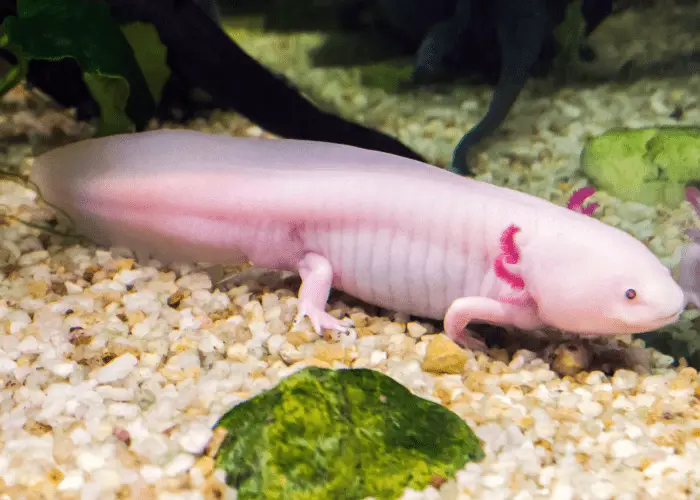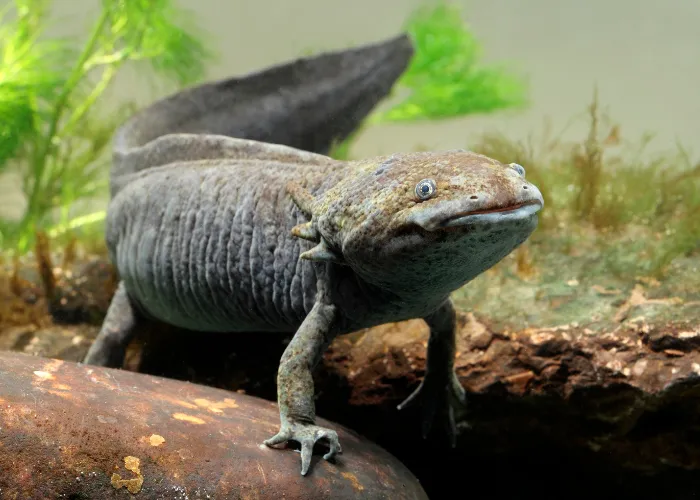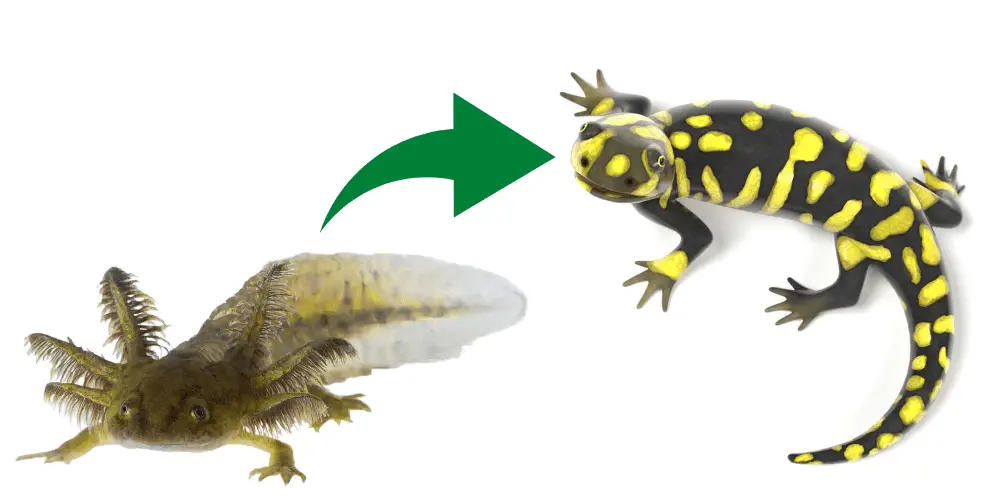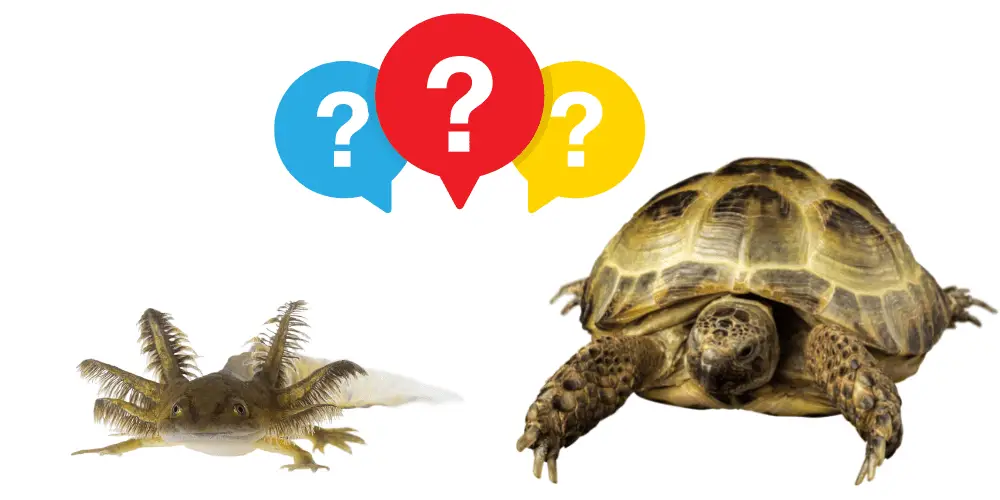There are a lot of strange and fascinating creatures out there, and without question, the Axolotl is among them. They don’t look much like how we envision a salamander, but can Axolotls turn into salamanders?
Axolotls can turn into salamander-looking creatures, but this metamorphosis is rare in the wild. These creatures are already a member of the salamander family but don’t look the part due to never losing their larvae-like appearance.
Why do Axolotls Morph?

Amphibious animals like Axolotls go through the metamorphosis from being water-dwelling creatures to land-based creatures.
This change is the amphibious version of what we would consider puberty- losing its Larval or child-like features and maturing into adulthood with all the tools necessary to move from the water to dry land.
For the vast majority of animals, this is a natural progression. However, when the Axolotl goes through this change, it’s because there’s something wrong or an environmental condition promoting this change.
Under normal conditions, the Axolotl doesn’t naturally produce the hormones necessary that signals the body to mature.
In the wild, a diet of insects containing high levels of iodine can shift their hormones into gear, yielding a metamorphosis. In captivity, it could be as simple as the chemical levels in the water that promote the change.
What Chemical Turns Axolotls into Salamanders?

Iodine produces thyroid hormones, which promote the animal’s body to shift gears into metamorphosis. This is a natural progression for most but unnatural for the Axolotl.
As mentioned above, insects are often the culprit in the wild when their bodies are high in iodine levels. Iodine exists in tap water as well, and sometimes the tap water can contain iodine levels high enough to promote metamorphosis.
Forced Transformation
Some pet owners attempt to force or induce metamorphosis in their Axolotl to change its current state into a salamander by deliberately injecting iodine into their water or food. When done incorrectly, this will kill the animal rather than promote a change.
That said, it can be done safely when done methodically, carefully, or correctly. Nonetheless, it’s often done unwittingly by accident.
How Long Does It Take for an Axolotl to Turn into a Salamander?
Once the change begins, it can take about a month before they start to look and behave more like a natural salamander.
Signs of Morphing in Axolotls

The first sign that they are going through the change is their dorsal fin begins to shrink– signaling that a tail is coming.
Next, the rest of its fins begin to shrink, as do its gills. At this point, you’d notice that the Axolotl is spending a bit more time toward the top of the water, taking an occasional breath.
This is when it’s time to furnish a tank with some land-like items to catch a break as it will eventually begin to seek an escape route from the water toward the end of its progression.
Its eyes will bulge out from either side of its head more than usual, and eventually, eyelids will form.
In the end, its skin will change color and texture, and you now have a fully developed salamander. From this point on, it will likely prefer land over water until its breeding time.
How Rare is it for an Axolotl to Turn into a Salamander?

The transformation of an Axolotl into a salamander is so rare in the wild that it is seen as unnatural. It happens more often in captivity for a couple of reasons.
The first reason we’ve already discussed- is the introduction of iodine through the tap water being used to sustain the animal. But the second reason is a bit more complex which crossbreeding.
Axolotls Crossed with Tiger Salamanders
Scientists at Boston University have concluded that all individual Axolotls in captivity are descended from only six individuals. As is true with any inbred species, negatives are amplified and more frequent than a more genetically diverse species.
To generate more genetic diversity, the Axolotl was cross-bred with Tiger Salamanders, which injected some much-needed genetic diversity into the species. But this does come with one particular consequence.
Becoming more genetically diverse via a species that naturally progresses into adulthood via metamorphosis is likely to promote this change without warning for some offspring. For this reason, though still rare, pet Axolotl is more likely to make the change than their wild counterparts, making it more frequent.
What is the Rarest Axolotl Morph?

The Rarest Axolotl Morph is the Non-Albino Golden Axolotl. Non-Albino Golden Axolotls (otherwise known as NAGs) remain a mystery to Axolotl breeders, as there is no known cause for this particular mutation. Some suspect that what causes this particular color scheme is a chromosomal anomaly.
They are non-albino, which gives them a sharp, dark pupil in the eyes. Their skin color is a gold flake, with black-tipped gills and fins.
Though a beautiful color, it does prove to be q rather unhealthy variety. Most of this type rarely reach adulthood. Those that do are typically females that remain unfertile.
The mutation’s rarity and the shotty survival rate make this Axolotl the rarest species.
WORTH A LOOK:
Final Thoughts

Though it is possible to force a morph of your Axolotl by introducing iodine into its system, is it a good idea?
Think about it for a minute…
At the pet shop, someone had to choose between purchasing a well-known salamander, a Tiger Salamander, and an Axolotl. Between the two, the Axolotl won them over.
Why would that person then change the Axolotl to resemble what was originally rejected?
I don’t feel like that makes much sense unless the person wants to be ringside for a month-long transformation.
But still, when this species goes through the change, it loses years of its lifespan. Though it can happen safely, the long-term effects are a much shorter life for your pet.
Related Questions:
1. What Are Axolotls?
Axolotls are paedomorphic salamanders. “Paedomorphic” is the word for living things that retain their juvenile features after adulthood.
Fortunately for those who enjoy the innocent and friendly expressions that the Axolotl exhibits, the vast majority of this species will retain these child-like features throughout its life. Those morphing from larval to adult salamander features are few, both in the wild and in captivity.
The Axolotl has various unique features, but in the end, they are considered salamanders. Tiger Salamanders are their closest relative- though a comparison between the two wouldn’t pass the eye test.
Because they retain their larvae state, they never lose their gills, and their tail has its fin-like shape to better move through the water. These are large as salamanders go, about 7-8 inches long and weighing about ½ a pound.
One incredible feature of this species is its ability to regrow recently missing limbs!
2. How Long Do Axolotls Live?
The average lifespan of an Axolotl is about 15 years, and Morphed Axolotls average more than 10 years. Those in the wild who make the change aren’t considered lucky, as the change alone sheds years from their lifespan.



